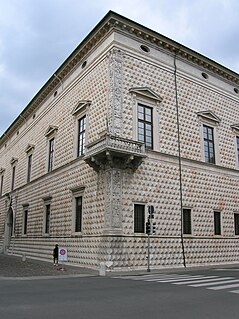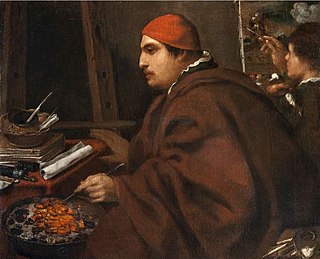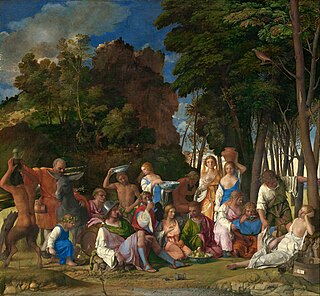
Giovanni Francesco Surchi (died c. 1590) was an Italian painter of the late-Renaissance period, active in Ferrara.

Giovanni Francesco Surchi (died c. 1590) was an Italian painter of the late-Renaissance period, active in Ferrara.
He was also called il Dielai or il Dialai, his father's nickname which derives from the Venetian exclamation of Dio l'ajuti or God help us. Giovanni Francesco, the son of Zanobio, who was a pupil of Dosso Dossi. [1] Orlandi found him facile with figures and grotteschi, and having a predilection for bizarre decoration.
He painted a Nativity at San Giovannino and the convent of the Benedictines in Ferrara. He painted the portrait of Ippolito Riminaldi. He painted frescoes for the Oratorio dell'Annunziata. He painted some medallions with the four evangelists for the church of the Gesu (Jesuits) in Ferrara. This was completed with the help of his pupil, il Bastarolo. [2]

Dosso Dossi was an Italian Renaissance painter who belonged to the School of Ferrara, painting in a style mainly influenced by Venetian painting, in particular Giorgione and early Titian.

Girolamo Da Carpi was an Italian painter and decorator who worked at the Court of the House of Este in Ferrara. He began painting in Ferrara, by report apprenticing to Benvenuto Tisi ; but by age 20, he had moved to Bologna, and is considered a figure of Early Renaissance painting of the local Bolognese School.

Benvenuto Tisi was a Late-Renaissance-Mannerist Italian painter of the School of Ferrara. Garofalo's career began attached to the court of the Duke d'Este. His early works have been described as "idyllic", but they often conform to the elaborate conceits favored by the artistically refined Ferrarese court. His nickname, Garofalo, may derive from his habit of signing some works with a picture of a carnation.

Alfonso d'Este was Duke of Ferrara during the time of the War of the League of Cambrai.

Lorenzo Costa was an Italian painter of the Renaissance.
The School of Ferrara was a group of painters which flourished in the Duchy of Ferrara during the Renaissance. Ferrara was ruled by the Este family, well known for its patronage of the arts. Patronage was extended with the ascent of Ercole d'Este I in 1470, and the family continued in power till Alfonso II, Ercole's great-grandson, died without an heir in 1597. The duchy was then occupied in succession by Papal and Austrian forces. The school evolved styles of painting that appeared to blend influences from Mantua, Venice, Lombardy, Bologna, and Florence.
Sebastiano Filippi was an Italian late Renaissance – Mannerist painter of the School of Ferrara.

Ortolano was an Italian painter of the Ferrara School, active in the Renaissance period. Ticozzi cites his birth as ca. 1480.

Palazzo dei Diamanti is a Renaissance palace located on Corso Ercole I d'Este 21 in Ferrara, region of Emilia Romagna, Italy. The main floor of the Palace houses the Pinacoteca Nazionale di Ferrara.

Giuseppe Mazzuoli was an Italian painter of the Mannerist period, active mainly in the court of Alfonso II d'Este of Ferrara.

Giuseppe Caletti or Calletti was an Italian painter and engraver of the Baroque period, active in Ferrara and Cremona. He often painted religious themes in a genre like dress and surroundings, including the theme of Bacchanalia like Titian.
Alfonso Rivarola was an Italian painter of the Baroque period, active mainly in Ferrara, where he was born. He is also known as il Chenda because of an inheritance he received from someone with that name.

Domenico Panetti (1460–1530) was an Italian painter of the Renaissance period, active mainly in his native Ferrara. Among his early pupils was Garofalo. He painted a Deposition from the Cross for the church of San Niccolo and a Visitation for San Francesco in Ferrara.

Lorenzo Leonbruno, also known as Lorenzo de Leombeni, was an Italian painter during the early Renaissance period. He was born in Mantua (Mantova), an Italian commune in Lombardy, Italy. Leonbruno is most well known for being commissioned by the court of Francesco Gonzaga, Marquis of Mantua, and his wife Isabella d'Este. The patronage continued with their eldest son Federico II Gonzaga, who was the fifth Marquis of Mantua. Leonbruno was the court painter for the Gonzaga family from 1506–24.
The decade of the 1490s in art involved some significant events.

The Feast of the Gods is an oil painting by the Italian Renaissance master Giovanni Bellini, with substantial additions in stages to the left and center landscape by Dosso Dossi and Titian. It is one of the few mythological pictures by the Venetian artist. Completed in 1514, it was his last major work. It is now in the National Gallery of Art in Washington D.C., which calls it "one of the greatest Renaissance paintings in the United States".
Battista Dossi, also known as Battista de Luteri, was an Italian painter who belonged to the Ferrara School of Painting. He spent nearly his entire career in service of the Court of Ferrara, where he worked with his older brother Dosso Dossi. It is believed that Battista worked in the Rome studio of Raphael from 1517 to 1520. Battista's students include Camillo Filippi.

Gabriele Cappellini was an Italian painter of the Renaissance. He was also called il Caligarino or il Calzolaretto, from his having first pursued that trade. He was born in Ferrara, and there trained under Dosso Dossi, he was active c. 1520. For the church of San Francesco, Ferrara he painted a St. Peter and St. James and for San Giovannino the principal altar-piece, representing The Virgin and Infant with several Saints.

Camillo Filippi was an Italian painter who flourished about the middle of the 16th century.

The Pinacotecta Nazionale is an art gallery in Ferrara, Emilia-Romagna, Italy. It is located on the piano nobile of the Palazzo dei Diamanti, a work of Renaissance architecture by Biagio Rossetti, commissioned by Leonello d’Este in 1447. Not to be confused with the Civic Museum on the lower floor, which has hosted temporary exhibitions of contemporary art since 1992, the Pinacoteca houses a collection of paintings by the Ferrarese School dating from the thirteenth to the eighteenth centuries. It was founded in 1836 by the Municipality of Ferrara after Napoleon's widespread dissolution of churches threatened the protection of important public artworks. The gallery is formed as much around notable northern Italian painters as it is around the exquisite interior decoration of the palace itself, together with remnants of frescoes from local churches and later acquisitions from the Sacrati Strozzi collection.
| Wikimedia Commons has media related to Giovanni Francesco Surchi . |